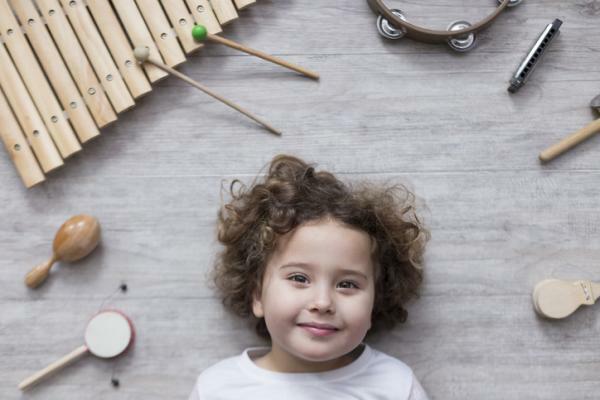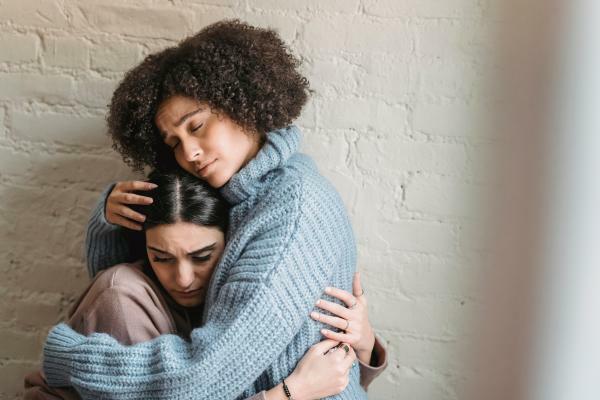
From pregnancy, the use of music is recommended as a beneficial factor for the development of the baby. From the 20th week of pregnancy, they already have the ability to hear and through music they can capture the mother's state of mind, as well as promote the creation of new neural connections.
The music therapy is the use of music as therapy in its different aspects to stimulate, develop and / or help reduce different factors that occur, either due to a pathology or development slow. Although music therapy is focused on adults and children with special needs or functional diversity, it is also used, at school, to promote optimal development in children and girls Another area where music therapy is widely used and has multiple applications is in old age.
In this Psychology-Online article we explain what is music therapy and its benefits.
Index
- What is music therapy
- Music therapy: benefits
- Music therapy: sessions
- Music therapy: activities
- In conclusion...
What is music therapy.
We can define music therapy as the use of music and its many benefits, either, in adults, as in children, also known as early musical stimulation. The use of music therapy is focused on the area of people with functional diversity, in old age and children with a slower or different development. Music in its different aspects, among many other benefits, helps to stimulate and develop different capacities. It is beneficial since it stimulates concentration, auditory, visual and tactile perception and promotes the development of psychomotor skills, coordination and movement of the body. In addition, if there is language capacity, with the songs the practice and knowledge of the language is favored, as well as the mobility of the mouth and the emission of the different sounds.
In addition to the multiple benefits mentioned above, the workshops can be individual or group. A music therapy workshop with other adults or children is even more enriching, since it stimulates social, affective and emotional relationships. It favors the development of social skills.
Music therapy: benefits.
The most important benefits of music therapy are: to facilitate, develop and support different areas of development. Among other benefits, music therapy serves to:
- Power the brain development and the creation of new neural connections.
- Stimulates the senses.
- It establishes a positive and joyful frame of mind.
- Helps body coordination and spatio-temporal position.
- It favors the expression, emotional and affective.
- Promotes expression and body movement.
- It encourages the development of the psychomotor skills of the body and hands.
- It favors the development of auditory, visual and tactile perception.
- Helps to recognize and identify sounds from instruments, songs, or body sounds.
- Help to manage anxiety and stress.
Music therapy: sessions.
Do you know what music therapy sessions are like? It is interesting to know what factors to focus on and how a workshop must be organized to be effective. The points explained below can be of great help when choosing between the different offers on the market.
There are three factors that should be observed before organizing a workshop music therapy:
- Who is it for: number of participants.
- Types or degrees of functional diversity: Depending on the type or degree of functional diversity presented by the people in the workshop, the proposals will be one or the other.
- Space where the workshop is taught: measurements, materials, furniture, accessibility and the area. The space must be adapted to the group without architectural barriers in the event that there is a person with reduced mobility.
The design must be organized depending on different factors. It is advisable to guide us through some aspects that can be of great help:
Adjusted expectations
If we have high expectations and many objectives, the group may not reach them and a feeling of failure may be created. Adjusting expectations to the possibilities and needs of the group will be of vital importance for the successful development of the workshop.
Observe the interests and needs of the group
Each group will have different interests and for the involvement of the members it is important to establish the proposals through their interests and needs. There will be groups that will be more interested in body expression and others in playing percussion instruments. If we do not serve group interests, they may not show interest and music therapy may not bring its benefits.
Flexibility
The sessions can have an established structure but it is also advisable to leave some flexibility. They may be more tired that day or simply have an interest in another aspect. You do not have to force anything. We must observe and be aware of when to change the proposal or on the contrary if it is not adequate to the needs of the group.
Experimentation, exploration and creativity
It is recommended that the sessions and their proposals be organized in a way that allows the possibility of experimenting, exploring and externalizing creativity. Experiential proposals that allow, for example, to know the instruments in their different aspects: the shape, weight, feel, if they are cold, metal or wood, how we touch it to make a sound, etc. In music therapy workshops it is advisable to avoid the use of cards, repetitive, little dynamic or forced exercises.
Give necessary importance to the game
When conducting a music therapy workshop, especially with children, it is vital that the necessary importance is given to the game. Children's play it is a necessity and it is in this way that through play children develop in an integral way. It is recommended that the proposals be focused from the game and for the game, because in this way, they will play while learning and they will learn while playing. If we try to saturate them with information or they are forced, we will receive a rejection from the child by ceasing to be actively involved.

Music therapy: activities.
There are multiple proposals to carry out in a session music therapy. Below we will see some of the music therapy proposals or exercises:
Body expression
- In this proposal we can present ribbons or fabrics to the members of the group.
- With the music that we choose, more or less moved, they will move through the space promoting corporal expression and the coordination of their body.
- You don't need to give too many instructions or impose rules, just we let flow. Usually, we can see that there are those who lie on the ground or who tie the headbands. In this case, it is flowing creativity and spontaneity, each in their own way. As long as it is in a good coexistence, everything is valid.
Instrument experimentation
- We can prepare an environment with different percussion instruments, grouped together or simply placed in a neutral way.
- Children or adults will have the possibility of experiment and explore the instrument that is of interest to you and discover different characteristics such as: what is it made of? Is it heavy? Is it cold because it is made of metal, or is it made of wood? How does it smell? How do I make it sound? Does it emit several tonalities?, etc.
- Another proposal could be to play the guitar, drums, piano, etc. Instruments that are a little more complex due to their size and structure, but with support (or not), can be a proposal with a high level of interest and active participation.
In this way, the objective is not that he learns to play the instrument but that he enrich of experimentation and self-exploration, autonomous.
Sing and dance
Something as simple as singing and dancing are two very complete and fantastic proposals! Simply putting music to taste and leaving freedom of movement, multiple aspects are enhanced such as the development of psychomotor skills, control of coordination or body expression. If, in addition, there is the ability to speak, and songs are introduced, language and oral mobility are practiced. If the songs are of interest to the members, it will still have a higher degree of participation. Here the importance of listening to wishes, group motivations and interests.
Preset games
Games like statues:
- When the music plays we keep moving by dancing.
- When the music stops playing (we pause it), we will remain as if we were statues, standing.
- It is not necessary to eliminate if someone moves, it is usually done but we will try to avoid negative factors and feelings of failure.
The traffic light game. We need two cards, one red and one green:
- When we show the green card, we dance to the rhythm of the music.
- When we show the red card, the traffic light turns red and while the music is playing, we stop.
These types of exercises are very valid as they help to know how to manage impulses and learn self-control. In real life it is important to know when we should control them.
Games of tones and intensity
- We will put a song in which changes in tone or intensity are very notable, we can also play a melody with the piano or guitar marking higher / lower or stronger / weaker registers.
- When the song sounds lazy, we crouch down by squatting.
- When the song gets louder, we stand up stretching our arms well touching the sky.
Another option is to separate the classroom in two and depending on the tone, we have to move from one side to the other. When it sounds sharp we will position ourselves to the right and when it sounds serious we will position ourselves to the left.
These proposals enhance the development of auditory perception, the distinction of tones and intensities. In addition, laterality and coordination of the body in relation to space are worked on. They generally work very well over a period of time no longer than 5 or 10 minutes, depending on the group.
Creation of instruments
The creation of instruments from recycling it is a very valid proposition. In the choice of materials we must observe the characteristics of the group to avoid accidents. If they are children or adults who put things in their mouths, we will not choose small items as they can cause choking.
For example, maracas made from containers of yogurt are a very common proposition. We need two cans of yogurt and put rice, chickpeas or lentils inside. Once introduced, we put the internal parts together and stick them with adhesive tape. We can decorate the maracas to taste.
Relaxation and breathing
Some children or adults may be nervous or very moved. Relaxation and breathing exercises can help you calm down at the beginning or end of the session. A proposal can be to put mats on the floor, we will lie down, close our eyes and with a relaxing music in the background we will breathe. We can propose to raise the legs, arms, stand on the side, or imagine a specific situation. In this article you will find 15 relaxation exercises for children.
In conclusion...
As we have seen, music therapy is very wide and very valid as support for various scopes. Music in its different aspects has multiple benefits both in children and adults with functional diversity, as in old age and, ultimately, for all people. If the practice is done correctly and the needs and interests of the group are respected, it can be an enriching and fun process.
This article is merely informative, in Psychology-Online we do not have the power to make a diagnosis or recommend a treatment. We invite you to go to a psychologist to treat your particular case.
If you want to read more articles similar to What is music therapy and its benefits, we recommend that you enter our category of Emotions.
Bibliography
- AA, V. (2001). Music therapy fundamentals.
- Gold, C., Wigram, T., & Elefant, C. (2007). Music therapy for autism spectrum disorder. The Cochrane Plus Library, (4), 9.
- Ortega, E., Esteban, L., Estévez, A. F., & Alonso, D. (2015). Applications of music therapy in special education and in hospitals. European Journal of Education and Psychology, 2 (2).


